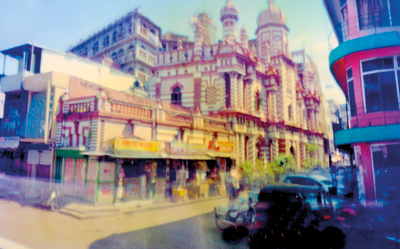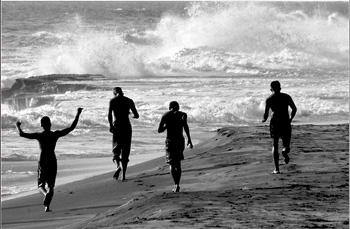Armed with a pinhole camera she’s set on a new life
Even before you hear her story, you know there’s something unusual about Liz Doles’ photographs of Sri Lankan buildings and monuments. Her beautiful images are unabashedly evocative and romantic, seeming to belong to an older, far simpler time. They have a fuzzy quality, for the lack of a better description, even though a closer inspection will reveal that every element is equally in focus. The streets are bereft of people but the light seems to endow structures like the Jami-Ul-Alfar mosque in Pettah with their own internal glow. The clues all point in one direction – a pinhole camera.

Liz with her pinhole camera.
The story of how she found herself in Sri Lanka, taking pictures with a spray painted laundry box isn’t a long one as Liz tells it. As a younger woman, she contracted acute ophthalmic thyroid disease or Graves’ Disease – it left her with severe double vision and a reduced perception of colour.
Her doctors had warned this single mother that she might lose her sight altogether so she was forced to undergo several difficult corrective surgeries over a number of years. In the end, her sight did finally stabilise. (Today, the only indications of anything amiss are the outsize red frames of her spectacles.) Unfortunately by the time Liz had recovered, she had irreversibly lost her momentum on her graphic design business – “I was no longer in the loop,” she says, confessing that she felt herself floundering in a field dominated by much younger people. Facing this amalgamation of artistic, physical, financial and professional crises head on, she chose to reinvent herself.
Though she enjoys painting and sketching, her photography is where her personal revolution really unfolded. She put together her own inexpensive equipment: a box which had an aperture made out of a tin can smoothed down with sand paper and curtained by a slice of tape acting as a lens cap. For Liz, her new pinhole camera was a delight and the pictures it produced were evenly bathed in a light that was neither day nor night. The entire image remained in focus across the picture plane. She explains how she loves the adventure of working without a viewfinder or LCD panel. Her composition instead is based on instinct, intuition and experience and is influenced by time of day, longitude and season and even then she never knows what she’s going to get. “The way I take pictures relies so much on serendipity,” says Liz.
Her unusual approach won her a Fulbright scholarship to live and work in Sri Lanka and she spent several months here taking photographs before heading back to the States, where she exhibited some of her work. The decision to return to the island was an easy one – she missed the warmth and the food, but most importantly she wanted more pictures. Liz was gunning for 1000 and she had only taken half that number.
“There’s a certain quality to life in Sri Lanka…I love the quality of the air, the colour of the light, it’s beautiful for photography,” she says. She was also interested in adding many more images to her series of portraits of Sri Lankans, collected under the category Lankavaa Lassanai. On the lookout for sponsors, she says she wants to stage a full scale exhibition, one where she can hang her prints at mural size and perhaps even produce a coffee table book.
We meet just after Liz has signed a contract that will keep her in Sri Lanka for the foreseeable future – quietly excited, she is still reverberating from the implications of her decision. Working at the Academy of Design, she intends to teach as well as assist in the administration of the institution. It is a great leap of faith, but one that Liz describes as incredibly liberating. “I packed up everything. I let go of my apartment. I don’t own any winter clothes now.” Everything she brought with her fit into two suitcases – “that was my whole life there,” she says.

Seen in a new light: The Jamil Ul- Afar mosque in Pettah
Now in Sri Lanka, she can savour the luxury of time. She has already travelled a bit with her dear friend Noeline Fernando but is planning more adventures in the coming months. On her day -long jaunts, she sometimes keeps to an itinerary, but more often than not, she just picks a bus and rides it to its last stop.
She’s confident she can always find her way back to Colombo.
The months she’s spent here have seen her grow accustomed to life on the island and she knows the way the light works here. 45 seconds to a minute of exposure will get her the image she wants, but she chooses also to work within other self-imposed parameters. “I don’t bring along tripods and better lighting,” she says, explaining that “these constraints make for a stronger image. It’s got to be what it is, in that moment and that’s part of what it means.”
Of course, these rules don’t always make for personal comfort. While conducting the delicate operation of transferring her light sensitive film from the camera to its bag on a street in Pettah, she found herself thoroughly unnerved to be looking into the eyes of a feral rat. She shudders theatrically while recounting the story, but we both know that it will take much more to drag Liz away from the beautiful heart of the old city.
“When I first came here, I thought that it was going to be about the architecture of religion and power and then I became interested in street corners and vernacular architecture just as much,” she says, examining her fascination with the seemingly mundane. “Where I sense a spiritual presence is where I put my camera.” The people too are a big draw. In the U.S.A attempting to take a photograph of a complete stranger is a process fraught with complications: “They ask me, ‘Are you with the government?’ In Sri Lanka, people just jump in front of the camera, literally. They’re happy to have their photograph taken,” says Liz.
For Liz, having embraced life in a new country, these are halcyon days, rich with promise. “I know I’m not done,” she says, “There’s so much more to come.”
Find out more about Liz online at www.lizdoles.com
Follow @timesonlinelk
comments powered by Disqus


























